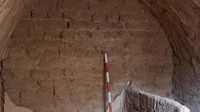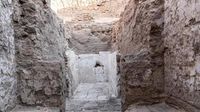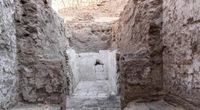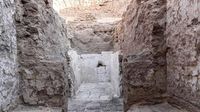In a remarkable discovery, archaeologists have unearthed the tomb of an unknown pharaoh in the necropolis of Abydos, Egypt, a site that has long been essential to our understanding of ancient Egyptian history. The tomb lies approximately seven meters beneath the surface, dating back around 3,600 years. The identity of the buried pharaoh remains elusive due to significant damage inflicted by tomb robbers, who stripped the chamber of artifacts and inscriptions that could reveal the ruler's name.
The tomb may belong to a member of the so-called Abydos Dynasty, a controversial lineage whose rulers reigned over parts of Middle and Upper Egypt during a turbulent period known as the Second Intermediate Period, roughly from 1650 to 1600 BC. This era saw the rise of the Hyksos kings, who exerted control over Egypt for a century, further complicating the region's historical narrative.
The archaeological team, led by Josef Wegner from the University of Pennsylvania, made this significant find while conducting excavations at Abydos, which is located about 160 kilometers north of Luxor and approximately ten kilometers from the Nile River. This site, renowned for its temples and tombs, served as a royal cemetery for early Egyptian kings and became a pilgrimage center dedicated to Osiris, the god of the afterlife.
Previously, in 2014, the tomb of Pharaoh Senebkay was uncovered nearby, suggesting the presence of the Abydos Dynasty in the region. The new tomb, however, is a second major royal find this year, following the February announcement of the discovery of Thutmosis II's tomb, which marked the first significant royal tomb discovery since the find of Tutankhamun’s tomb in 1922.
The newly discovered tomb features a spacious chamber carved from limestone, measuring about five meters in height and adorned with mud-brick arches. Unfortunately, tomb robbers had already ransacked it, leaving little more than remnants of the original burial goods and sparser decorations. Nevertheless, some inscriptions have survived, bearing the names of deities Isis and Nepthys, heightening the tomb's connection to ancient mortuary practices.
According to Wegner, “Remnants of inscriptions are visible on either side of the chamber entrance,” indicating the tomb’s royal significance. However, the extent of the damage to these hieroglyphs means the pharaoh’s name cannot yet be identified. Thus, it remains a mystery as to who this pharaoh might have been, although archaeologists hypothesize their significance due to the tomb's size, which surpasses those linked to the Abydos Dynasty.
Mohamed Abdel Badie from the Egyptian Antiquities Authority emphasized that the tomb's dimensions could indicate that it belonged to one of the notable rulers who predated Senebkay, further complicating the already enigmatic history of Egypt's dynasties. Many of the rulers from the Abydos Dynasty, including Senebkay, faced challenges from the Hyksos invaders, leading to violent confrontations characterized by brutal executions and mutilations on both sides.
The Abydos site itself holds considerable historical weight, as it was one of the first cities in ancient Egypt associated with early royal tombs. The mysteries surrounding the Abydos Dynasty, amidst limited archaeological evidence, have long prompted discussions about the dynasties that ruled in the shadow of foreign warriors.
“The discovery of the king's tomb in Abydos offers new scientific insights into the evolution of royal tombs in the Anubis Mountain necropolis,” said Mohamed Ismail Khaled, Secretary General of the Supreme Council of Antiquities. This new finding not only enhances the understanding of burial traditions but also provides context for the sociopolitical dynamics that existed between the indigenous Egyptian pharaohs and their Hyksos adversaries.
As researchers continue to study this tomb and its contents, they hope to unravel the identity of the buried pharaoh and contextualize their reign more accurately within the broader spectrum of Egyptian history during this significant transitional period. The mystery surrounding the tomb's owner reflects not just the intriguing political history of ancient Egypt but also highlights the ongoing collaboration between local and international teams dedicated to bringing forth the stories hidden by time.
With this backdrop, the discovery of such royal tombs signifies an extraordinary year for Egypt’s Ministry for Tourism and Antiquities, marking it as a pivotal moment in Egyptology that invites both scholarly and public interest. The enigmatic history of the Abydos Dynasty, the age of the tomb, and the rich archaeological conclusions that emerge will no doubt lead future investigations into the depths of Egypt's storied past.







